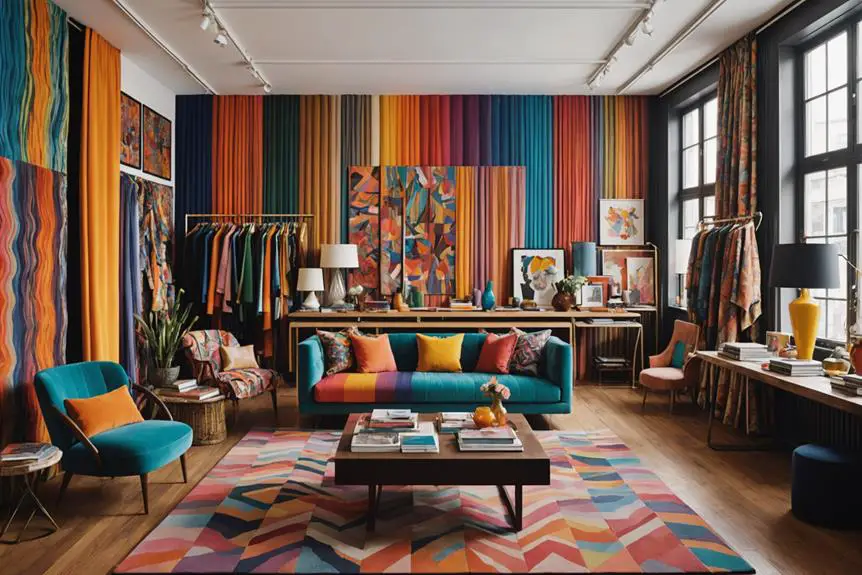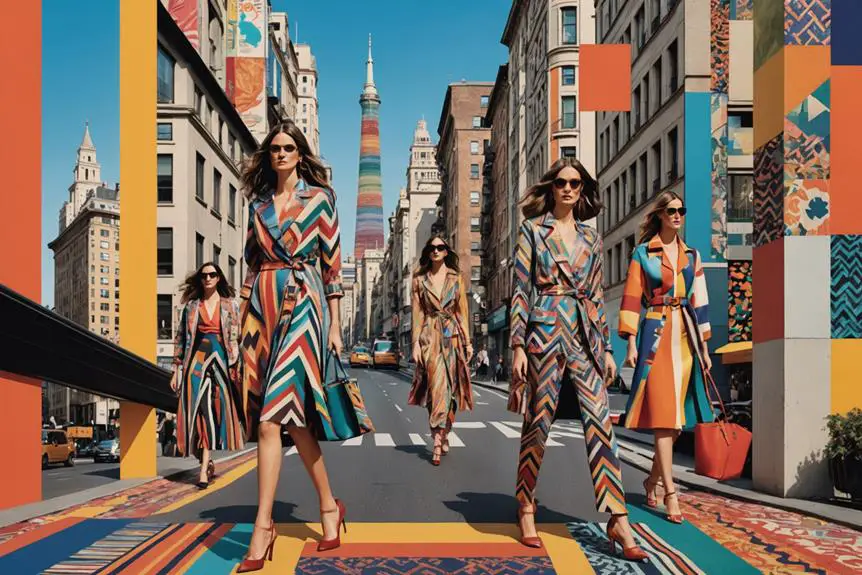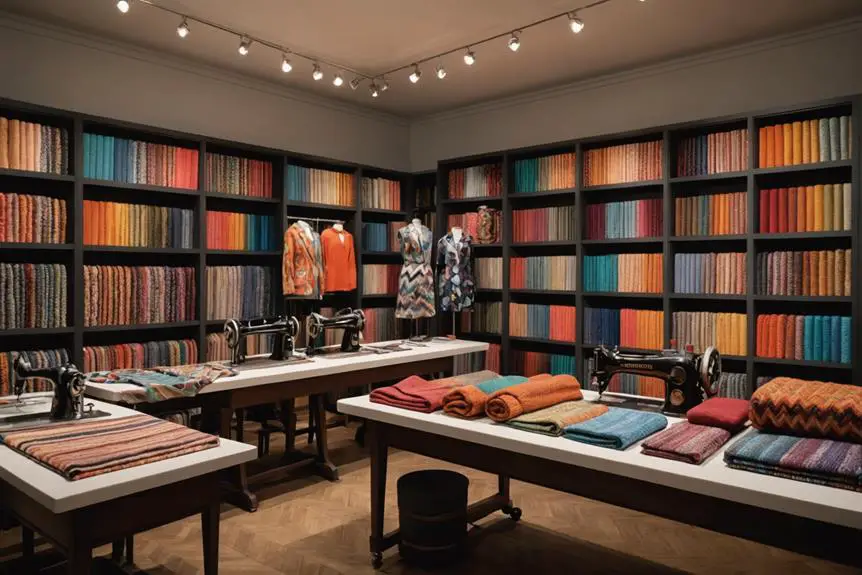Missoni's history unfolds as a captivating tale of innovation and creativity within the fashion realm. Established in 1953 by Ottavio and Rosita Missoni in Gallarate, Italy, the brand quickly garnered attention with a substantial order of 500 dresses. By 1958, their inaugural fashion collection debuted in Milan, signifying their rise in the industry. Over the decades, leadership transitioned, especially when Angela Missoni took charge in 1998. The brand diversified into various markets, including children's fashion and home goods, all while upholding a steadfast commitment to philanthropy and cultural engagement. Missoni's enduring legacy continues to resonate, inviting further exploration of its rich narrative.
Early Beginnings

The birth of Missoni in 1953 marks a pivotal moment in the fashion industry, driven by the creative vision of Ottavio Missoni and Rosita Jelmini. Initially starting as a knitwear workshop called Maglificio Jolly in Gallarate, Italy, the couple's innovative approach quickly attracted attention. Their significant order of 500 dresses from La Rinascente propelled the brand into the limelight, prompting the name change to Missoni, which now resonates globally.
Ottavio and Rosita's journey began at the 1948 Olympics in London, where they met, leading to their engagement in 1951 and marriage shortly after. Their early designs showcased vibrant colors and intricate textures, setting them apart in the Italian fashion scene. This experimentation laid the groundwork for the Missoni aesthetic that would later dominate runways and wardrobes alike.
The couple's first collection, presented in Milan in 1958, became a defining moment, garnering support from influential figures such as fashion editor Anna Piaggi. Her endorsement not only solidified Missoni's reputation but also highlighted the brand's contribution to the evolution of knitwear within the broader context of Italian fashion.
Key Milestones
Throughout its history, Missoni has marked several key milestones that not only shaped the brand but also influenced the broader fashion landscape. Founded in 1953 by Ottavio and Rosita Missoni, the label initially started as Maglificio Jolly. The pivotal moment came in 1958 when the first collection was presented in Milan, earning the support of influential fashion editor Anna Piaggi. This launch was significant, as it established Missoni's presence in the competitive fashion world.
The brand gained international fame in 1967 during a sensational fashion show at the Pitti Palace, where models exhibited sheer fabrics, pushing boundaries and challenging societal norms. As the business grew, by the early 1970s, womenswear accounted for 60-70% of total revenue, solidifying Missoni's status as an iconic Italian brand.
In 1998, Angela Missoni took the reins, marking a new era for the label, ensuring the continuation of its rich legacy.
| Year | Milestone | Impact |
|---|---|---|
| 1953 | Founded by Ottavio & Rosita | Established Missoni label |
| 1958 | First collection in Milan | Entry into fashion world |
| 1967 | Pitti Palace fashion show | Gained international attention |
| 1998 | Angela Missoni takes over | New leadership era begins |
Leadership Changes

Leadership at Missoni has evolved considerably over the years, reflecting changes in both the brand's vision and the broader fashion landscape. Angela Missoni took the helm as creative director in 1998, guiding the brand after her mother, Rosita Missoni, shifted focus to Missoni Home. This marked the beginning of a dynamic era, but it wasn't until January 2013, following Vittorio Missoni's tragic death, that the brand experienced a significant leadership change. Control passed to his siblings, Luca and Angela, prompting a reevaluation of strategic direction.
In 2018, the Missoni family sold a 41.2% stake to Fondo Strategico Italiano, while still holding 58.8% ownership, highlighting a new phase in governance and operational strategy. The brand's leadership continued to adapt with the appointment of Alberto Caliri as head of womenswear in 2021, indicating a change towards specialized roles within the hierarchy. This progression culminated in 2022 when Filippo Grazioli was named the new creative director, ushering in fresh perspectives and innovative ideas. These changes underscore the Missoni family's commitment to evolving the brand while honoring its rich heritage.
Brand Extensions
In recent years, Missoni has strategically expanded its brand through various extensions that reflect both its heritage and contemporary market demands. One notable revival is Missoni Sport, initially launched in 1985, which relaunched in 2022 as a wellness line, featuring a capsule collection designed in collaboration with soccer player Mike Maignan in 2023. This move aligns with the growing trend of athleisure and wellness.
M Missoni, first introduced in 1998 and brought in-house in 2018, was discontinued by 2021, showcasing Missoni's responsiveness to shifting market dynamics. Meanwhile, Missoni Home, established in 1981, continues to thrive, particularly through collaborations such as that with Acqua Livingstone and luxury projects in Dubai and the Maldives.
The Hotel Missoni venture, which launched in 2005, saw initial success with hotels in Edinburgh and Kuwait City but closed in 2014 due to market challenges. Finally, Missoni Kids has made a comeback after renewing its licensing agreement in 2022, aiming to recapture the children's fashion market. Collectively, these brand extensions reflect Missoni's adaptability and commitment to exploring various lifestyle segments while honoring its rich legacy.
Marketing Strategies

Missoni's brand extensions not only showcase its adaptability but also highlight the innovative marketing strategies that have propelled its growth in competitive markets. By leveraging limited-edition collections like "Missoni for Target," which gained significant attention in 2011, Missoni successfully positioned its products within the accessible luxury segment. This strategy not only attracted new consumers but also reinforced its brand identity.
The global licensing agreement with Estée Lauder for its fragrance line, initiated in 1982, exemplifies Missoni's commitment to quality and exclusivity. This partnership has allowed the brand to expand its presence while maintaining its artistic vision. Additionally, the five-year agreement with Safilo, signed in 2018, to produce eyewear collections under the Missoni brand, further diversifies its offerings.
Moreover, the collaboration with Timex Group in 2019 for watch production demonstrates Missoni's strategic approach to scaling its accessory range. High-profile advertising campaigns featuring renowned photographers like Juergen Teller effectively communicate the brand's vibrant aesthetic, reinforcing its market position. Collectively, these marketing strategies have enhanced Missoni's appeal, ensuring its products resonate with both loyal customers and new audiences alike.
Philanthropic Efforts
Philanthropy plays a significant role in Missoni's brand ethos, demonstrating a commitment to social responsibility that resonates deeply with its clientele. The brand's philanthropic efforts include notable collaborations, such as the 2017 partnership with Jennifer Lopez, which resulted in a limited-edition tee collection. This initiative raised funds for the Women's Cancer Research Fund, supporting 12 different cancer charities. Such charitable initiatives not only highlight Missoni's dedication to critical causes but also engage its consumer base in meaningful ways.
In addition to its collaboration with Lopez, Missoni has partnered with Saks Fifth Avenue to enhance fundraising efforts through various charitable initiatives. This partnership reflects Missoni's proactive approach to social responsibility, as it actively engages in community initiatives that align with its core values. The company's involvement in various philanthropic efforts has been documented by major publications, showcasing its commitment to giving back and raising awareness for pressing social issues.
Ultimately, Missoni's philanthropic endeavors reveal a brand that prioritizes its community, ensuring that its influence extends beyond fashion into areas that genuinely matter to its clientele and society at large.
Cultural Impact

A significant cultural force, Missoni transformed the fashion landscape with its innovative designs and vibrant color palettes during the 1960s and 1970s. The brand's bold use of color and playful patterns didn't just redefine knitwear; it also resonated with the broader cultural movement of the era, inspiring future designers and trends.
Consider the following key influences of Missoni:
- Challenging Norms: The 1967 fashion show, featuring sheer Lurex tops and braless models, popularized the term "braless flawless," pushing boundaries and redefining female beauty standards.
- Collaborative Spirit: Collaborations with fashion editor Anna Piaggi and others elevated Missoni's status, showcasing its versatility and creative prowess within the industry.
- Artistic Engagement: Missoni's participation in cultural exhibitions and theatrical costume designs illustrated a commitment to artistic expression that transcended traditional fashion.
Through these innovative designs and impactful collaborations, Missoni not only made a mark on the fashion world but also cultivated a legacy that continues to influence contemporary artistry and style today. You can see how Missoni's approach helped shape a cultural dialogue around fashion that remains relevant.
Frequently Asked Questions
What Is the Story Behind Missoni?
You'll discover Missoni's story is woven with vibrant colors and innovative knitwear, starting from a small workshop to becoming a fashion icon. Its unique zigzag patterns reflect a blend of tradition and modern creativity.
What Is so Special About Missoni?
Missoni's unique blend of vibrant colors, iconic zigzag patterns, and commitment to sustainability sets it apart. You'll appreciate their innovative approach, merging traditional craftsmanship with contemporary design, creating not just fashion, but a lifestyle experience.
Is Missoni Still Family Owned?
Yes, Missoni's still family-owned, with the Missoni family controlling 58.8% of the brand. Even after selling a stake, they actively influence its direction and maintain leadership roles in various creative aspects.
Is Missoni Owned by Valentino?
No, Missoni isn't owned by Valentino. The Missoni family maintains control, having sold only a minority stake to Fondo Strategico Italiano. This guarantees Missoni's unique identity and creative direction remain distinct from Valentino's brand.




